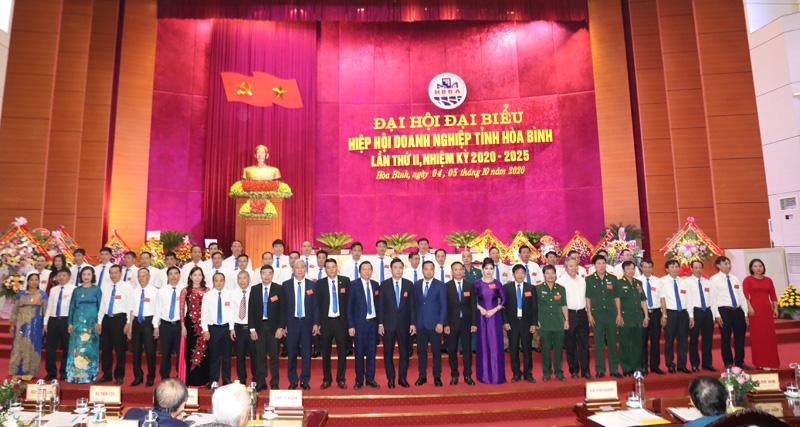
(HBO) - The second Congress of the Business Association of Hoa Binh province for the 2020 – 2025 tenure recently took place at the provincial Culture Palace.
The association now has 17 chapters in all
districts and city with over 700 members. The number of enterprises and
businesspeople has grown in both quantity and quality, increasingly affirming
their stature in local socio-economic development. During the 2016-2019 period
and the six months of 2020, the province recorded 1,586 newly-established
firms, or a 1.21 fold-increase from the 2011-2015 period.
 The executive board of the
provincial Business Association for the second tenure debuts.
The executive board of the
provincial Business Association for the second tenure debuts.
The congress elected an executive board
for the 2020-2025 tenure with 65 members. Nguyen Cao Son was re-elected as chairman
of the association and 10 others were voted as deputy chairpersons. Secretary
of the provincial Party Committee Ngo Van Tuan was elected its Honorary
Chairman.
Speaking at the event, Chairman of the
provincial People’s Committee Bui Van Khanh spoke highly of the association’s
role with contributions to the successful implementation of the Resolution
adopted by the 16th provincial Party Congress.
Looking into difficulties and challenges
amid intensive and extensive integration, he stressed that the Resolution set
the target of having 2,500 more firms and cooperatives, nearly 5,000 effective
companies and cooperatives during the 2021-2025 period, nearly doubling from
that in 2020. The State budget revenue is expected to reach 10 trillion VND by
2025.
President of the Vietnam Chamber of
Commerce and Industry (VCCI) Vu Tien Loc and Chairman of the Vietnam
Association of Small and Medium-Sized Enterprises Nguyen Van Than lauded the
association’s contributions to local socio-economic development.
Stressing that it was a congress of
action-minded people, Loc asked local firms to offer suggestions to local
leaders to create a safe business environment meeting international standards. The
association was required to protect legitimate interests of each firm and
restore their trust. The province was also urged to effectively build policies
and action plans to remove difficulties faced by firms in the near future./.
According to data from the Hoa Binh Provincial Party Committee, the industrial production index for the first six months of 2025 is estimated to have increased by 20% compared to the same period last year. This marks the highest year-on-year growth rate for this period since 2020.
In the first six months of 2025, Hoa Binh province’s export turnover was estimated at 1.145 billion USD, marking an 18.11% increase compared to the same period in 2024. Import turnover was estimated at $ 804 million, a 17.15% increase, which helped the province maintain a positive trade balance.
The lives of the ethnic minority farmers in Tan Lac district have gradually improved thanks to the new directions in agricultural production. This is a testament to the collective strength fostered through the professional associations and groups implemented by various levels of the district’s Farmers’ Union.
With the motto the "product quality comes first,” after nearly one year of establishment and operation, Muong village’s Clean Food Agricultural and Commercial Cooperative, located in Cau Hamlet, Hung Son Commune (Kim Boi district), has launched reputable, high-quality agricultural products to the market that are well-received by consumers. The products such as Muong village’s pork sausage, salt-cured chicken, and salt-cured pork hocks have gradually carved out a place in the market and they are on the path to obtaining the OCOP certification.
In the past, the phrase "bumper harvest, rock-bottom prices" was a familiar refrain for Vietnamese farmers engaged in fragmented, small-scale agriculture. But today, a new spirit is emerging across rural areas of Hoa Binh province - one of collaboration, organisation, and collective economic models that provide a stable foundation for production.
Maintaining growing area codes and packing facility codes in accordance with regulations is a mandatory requirement for agricultural products to be eligible for export. Recently, the Department of Agriculture and Environment of Hoa Binh province has intensified technical supervision of designated farming areas and packing facilities to safeguard the "green passport" that enables its products to access international markets.



 The executive board of the
provincial Business Association for the second tenure debuts.
The executive board of the
provincial Business Association for the second tenure debuts.